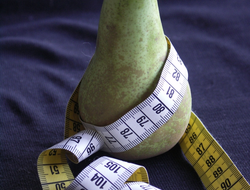Body Composition
Published: June 12, 2020
Body composition refers to the relative percentage of lean and fat tissue in your body. Being under or over fat may have negative health effects.
Body composition is considered a health indicator and may be more important than body weight measurement.
Body composition is usually measured in terms of body fat percentage.
Good health has been identified with body fat within a range of 10% -25% for men and between 18%-30% for women.
Body fat percentages between 5%-13% (men) and 12%-22% (women) are more typical in people who are very active.
The minimum level of body fat, which is identified as essential body fat, for men is 5% and for women is 8% body fat.
Essential fat is the minimum amount of fat required by your body which is necessary to maintain health.
Striving to be too lean can bring about negative health consequences. As people age, being underweight may make it difficult for a person to maintain lean body tissue.
Loss of lean body tissue may compromise the immune system and when fat reserves are low less energy is available to fight off infection.
The risk of osteoporosis and bone fractures increases for people who are underweight.
Low fat stores also result in low stores of fat soluble vitamins: vitamins A, D, E, and K. For women in particular, being too lean can result in amenorrhea (absence of menstrul periods) which may lead to infertility.
Striving to be too lean may lead to or result from an eating disorder, such as anorexia nervosa, which may negatively affect every physiological system in the body.
Having too much body fat may increase the risk of cardiovascular disease, hypertension, atherosclerosis, osteoarthritis, gall bladder disease, respiratory problems, diabetes type 2, and increases the risk of complications during surgery and pregnancy.
This is especially the case if body fat accumulates around your organs in your abdominal cavity (visceral fat rather than under the surface of your skin (subcutaneous fat).
Body fat that is carried on the hips and thighs does not appear to increase health risks and for pregnant and breast feeding women provides a source of energy to support the growth of the fetus and breast milk production.
Measurement
There are several methods for measuring body composition.
Fat or skin fold measurements estimate body fat by measuring folds of skin at various sites of the body with callipers.
Measurements are compared with standards. A better understanding of body composition comes when fat folds at several sites are measured.
Hydro densitometry or underwater weighing measures body density from which the body composition can be estimated.
Body composition can also be measured by bioelectrical impedance, Air displacement plethysmography, and Dual energy x-ray absorptometry (Dexa).
Body fat measurement, body weight, body mass index and waist circumferance can all be used as health indicators.
To learn more about a healthy body composition follow the links embedded in the article to other articles on this website.
References
1.
Corbin, C.B. & Lindsey, R. (1994). Concepts of physical fitness. Madison, WI: Brown & Benchmark.
2.
Whitney, E. & Rady Rolfes, S. (2005). Understanding Nutrition. Belmont, CA: Thomson Wadsworth

